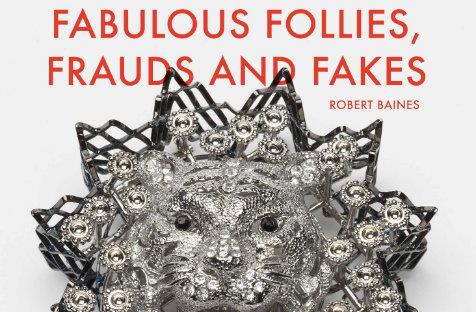From the author of Schmuck Stories no. 1 and More Amazing Schmuck Stories comes The copybook of copies: Fabulous Follies, Frauds and Fakes.
Neither of the first books was a result of a misalignment of the planets in the world of high art publishing. That’s confirmed by Robert Baines’ latest offering, The copybook of copies: Fabulous Follies, Frauds and Fakes, again from Australian Scholarly Publishing.
Embracing the word ‘schmuck’ was for artificer and goldsmith, Baines, more than an entertaining irony or eye-catching epithet.
The revered Schmuckashau in Munich has for five decades arbitrated taste in art jewelry. Evoking the revered name in these contexts is more like failing to show due deference in the presence of the Royal family than establishing ironic commentary.
In the introduction to Fabulous Follies, Frauds and Fakes, Dr Judith Callaghan from the University of NSW, captures the quality that flows through Baines recent work, both as goldsmith and as author.
‘Anyone who has spent time with Robert knows he’s a very funny man with a wicked sense of humour. He delights in playing with our expectations and with conventions–most particularly historical, curatorial and museological conventions. He is fascinated by fakery, so in his hands historical narratives are especially vulnerable.’
Baines has recently retired from a professorship in goldsmithing at RMIT University and, most recently, won the Herbert Hofmann Preis 2013 at Schmuckashau for a collection of works that framed bling in high art jewelry settings.
Ostensibly, Follies, Frauds and Fakes, relates to 83 works of jewelry, created for the exhibition Robert Baines: Metal, presently touring Australia as part of the Living Treasures: Master of Australian Craft series. But its relationship is, to use the author’s words, one of ‘authentication and stimulation’, rather than catalogue.
The first chapter of Fabulous Follies, Frauds and Fakes is Armbandits: The Story of a Postcard. It takes us on a journey from a Metropolitan Museum of Art postcard, illustrating an Iranian armlet from the 11th century, via pharaoh Hatshepsut (Egypt: 18th Dynasty), a woman, finally to pose and answer the culinary question on everyone’s lips: ‘is it possible that the design of the marshmallow biscuit [such as the Iced VoVo] is the result of a series of misinterpretation of an eleventh century armlet?’
The subsequent two chapters are a contrast. Chapter two is a whimsical contemplation titled Collecting: The Things People Collect. It examines what the author terms the ‘smallest collection of large jewelry in the world’. The collector is unnamed, perhaps hypothetical, but has aristocratic, sophisticated taste’. The chapter charts changes in tastes and values among collector, especially of the crafts, and ventures a discussion of Damien Hirst and the Old Masters. Hirst comes off second best.
Chapter three is titled The Official History of the Compact Disc, and you’ll safely guess the audio CD only rates a brief note. The compact – read small disc – has been at the heart of jewelry since primitive man hung shells about his neck.
I couldn’t see many shell in Follies, Frauds and Fakes, but there are many fine photographs of modern art jewelry, accompanied by a text that is both informative and plays with ‘historical, curatorial and museological conventions’, with a humour that is both academic and disrespectful at the same time.
Fabulous Follies, Frauds and Fakes is a wonderful antidote to the pomposity that sometimes replaces scholarship in the high art discourse.
The copybook of copies: Fabulous Follies, Frauds and Fakes
By Robert Baines
Hardcover, 80pp, RRP $49.95
ISBN 978-1-921875-98-4
Australian Scholarly Publishing






